Last week I ran across, again, the figure that Americans waste 40 percent of our food, which was widely reported last summer. I got to wondering how much of that was meat, because I am (and try to remain) keenly aware that meat is not merely pounds and calories and grams of protein; it’s the body of a once-living creature. Not that wasting bread or vegetables is a great thing, but I don’t see it as the same kind of moral issue as wasting meat. So I did a bit of research, and here’s what I found.
According to the Natural Resources Defense Council, in the United States, Canada, Australia, and New Zealand collectively, 22 percent of all meat produced is wasted. I’ll assume that we waste that much of our meat specifically in the U.S., though if anything the fraction here is probably higher. (I stopped myself from writing “only” 22 percent; it’s only “only” in comparison to the 40 percent overall.)
How much meat is that? The USDA projected that Americans would eat 166 pounds of meat per person in 2012, so we wasted 36.5 pounds each, about an ounce and a half a day, which doesn’t seem like much. On the other hand, if you multiply 36.5 pounds by 300 million people, you get a really big number. But we’re surrounded by really big numbers. We swim in them. We practically drown in them. I don’t think they mean much to most people. So what?
Let’s think of it instead in terms of lives. Of that 166 pounds of meat, 70 pounds were poultry, of which 16 pounds were turkey. Assume duck and goose are statistically insignificant; that leaves 54 pounds of chicken per capita. We get, on average, about 2½ pounds of edible meat from a chicken bred for meat production (about 60 percent of a 4-pound carcass), so Americans ate about 28 chickens apiece in 2012. If 22 percent of that meat was wasted — assume for the sake of argument that it’s the same percentage for all types of meat — the average American wasted 6 chickens last year.
My back-of-the-envelope calculations show that we also waste one and a half turkeys, a third of a pig, and a tenth of a steer, apiece, per year. But let’s just focus on the chickens for a minute.
I happen to have six chickens in my backyard, laying eggs for me and my family. They’re not pets, as I have insisted from the beginning, but they’re friendly, curious creatures, and good to have around. One flattens out to be petted when I come around, and a couple root up the leaves under my study window every morning, chuckling to themselves. The Barred Rock, when she gets bored, runs up the stairs to the back deck to see if anybody wants to come out and watch her lay her egg. One of the Orpingtons flies up on the roof of the coop to keep an eye on me when I’m watering them. They’re not people, they’re not pets, we keep them for their eggs, I don’t necessarily rule out the possibility of eating a few of them someday if they quit earning their keep — but they’re fellow creatures nevertheless, deserving of a certain amount of respect.
And the average American wastes the equivalent of that flock of chickens every year — is responsible, directly or indirectly, for killing six chickens, taking six lives, to no purpose, and chucking them in the trash. In other words, this:

Photo by Kathy.
…in the landfill. Yes, animals die every day, often pointlessly. So do people. But even roadkill gets eaten by the vultures; it isn’t wasted.
People talk about “putting a face” on things like poverty or war, so I guess if you want to put a face on food waste, or six of them rather, there they are.